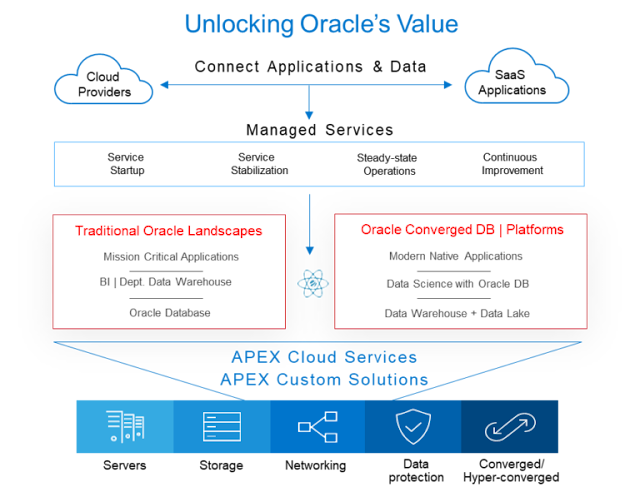According to a recent research study commissioned by Oracle in concert with ESG, 84% of organizations surveyed use at least one emerging technology in production to enhance finance and/or supply chain operations. Examples cited include:
◉ Artificial intelligence (AI) to recommend products, predict equipment malfunctions, and optimize store inventories.
◉ Internet of things (IOT) to drive operational health and insight (eg: automated inventory, asset, and fleet monitoring).
◉ Digital assistants with secure conversational AI for complex questions, such as financial position, sales forecasts, etc.
◉ Blockchain to create trust and efficiency across the supply network (eg: decentralized ledgers, sales documents, contracts).
Underpinning this change are new database architectures and capabilities, such as Oracle’s converged database advancements that now replicate the functionality of multiple special-purpose databases, bringing together structured operational data with unstructured data, AI, ML and IoT. The result? Traditional ERP and finance applications work with emerging applications in a data-driven business, making it possible to:
◉ Reduce IT cost and complexity with a single database that supports multiple data types and workloads.
◉ Provide consistent security, scalability and high availability for applications and data.
◉ Create data-driven applications by employing modern development paradigms, such as CI/CD, REST APIs, powerful SQL and event-streaming capabilities and Oracle database containers.
What does this mean for IT?
Simply stated, IT is being disrupted. From the Oracle side, as applications and database managers plan their roadmaps for embracing new Oracle application capabilities, IT infrastructure and services must be prepared to:
◉ Operate Oracle with maximum efficiency on modern Infrastructure as a service (IaaS).
◉ Scale Oracle infrastructure with predictability, flexibility and control.
◉ Enable intelligent data-driven Oracle applications by securing developer productivity and visibility for all data.
How Dell Technologies APEX comes into focus
First, we work with IT to operate Oracle with maximum efficiency by consolidating complex Oracle landscapes with APEX Custom Solutions on modern IaaS, freeing up valuable resources for high-value Oracle projects. We handle the day-to-day infrastructure management and keep you informed about issues, activities and performance, relieving Oracle DBAs and IT staff from these repetitive tasks. When it comes to performance, protection and availability, we provide efficient, intelligent IaaS that scales with Oracle demands.
Second, we enable you to scale your Oracle IT as you grow to maintain predictability, flexibility and control of IT investments. Since not all Oracle environments and landscapes are the same, we provide choice and flexibility with an end-to-end portfolio of IaaS (compute / storage/ data protection) designed specifically with Oracle applications in mind. And, when it comes to consumption, we offer metering and utility-based financial options that scale to match your actual usage.
Third, we enable data-driven Oracle applications and databases, addressing developer productivity by supporting demands of Oracle’s newest databases and applications. Examples include:
◉ Securing data with cyber confidence by protecting Oracle applications data with cyber‑resilient IT and a path to recovery from ransomware and destructive cyberattacks.
◉ Accelerating DevOps with persistent storage services that simplify the provisioning and protection for Oracle container-based databases supporting stateful apps and databases.
◉ AI‑enabling infrastructure that provides modern compute, GPUs, storage and networks to ensure high performance for in-memory database workloads with ML, blockchain.
◉ Streamlining data ingestion and access, unifying data streams with unlimited retention providing access to both real-time and historical events working with object storage.
Use Cases
A key ingredient for Dell Technologies APEX is our Validated Designs for Oracle. Dell Technologies Validated Designs are tested and proven configurations for Oracle use cases. I have highlighted a few below for your reference:
Consolidate Oracle landscapes
Whether planned or unplanned, over time, sprawling Oracle application and database landscapes running core business functions can become complex to manage and maintain. To address this, a great starting point is to consolidate and reduce TCO for Oracle running on “siloed” IT, with platforms ready to run mixed OLTP, OLAP and analytic workloads.
Run Oracle databases on containers
While container technology enables development teams to quickly provision isolated databases without the traditional complexities, when it comes to stateful applications dependent on consistent data, you need to maintain persistent data somewhere on the network, providing performance, scalability, resiliency and availability. Dell EMC storage platforms address this by dynamically provisioning persistent volumes and securing the Oracle databases containers.
Oracle Big Data SQL
To move from information source to actionable insights, organizations are investing in data management strategies that use data warehouses, data marts, data lakes and so on. Dell Technologies validated designs for data virtualization provide an efficient and seamless experience with Oracle Big Data SQL and highly scalable storage services.
Oracle MySQL Database
Oracle MySQL InnoDB is one of the most widely used open-source databases. A key feature is its ability to support different storage engines. Depending upon the engine used, MySQL can accelerate workloads, including Online Transaction Processing (OLTP), in-memory OLTP, data warehouses and Very Large Databases (VLDB). Dell Technologies combines the value of MySQL with InnoDB clustering and the advanced storage capabilities for a high availability solution that transforms both traditional and modern workloads.
Source: delltechnologies.com







0 comments:
Post a Comment